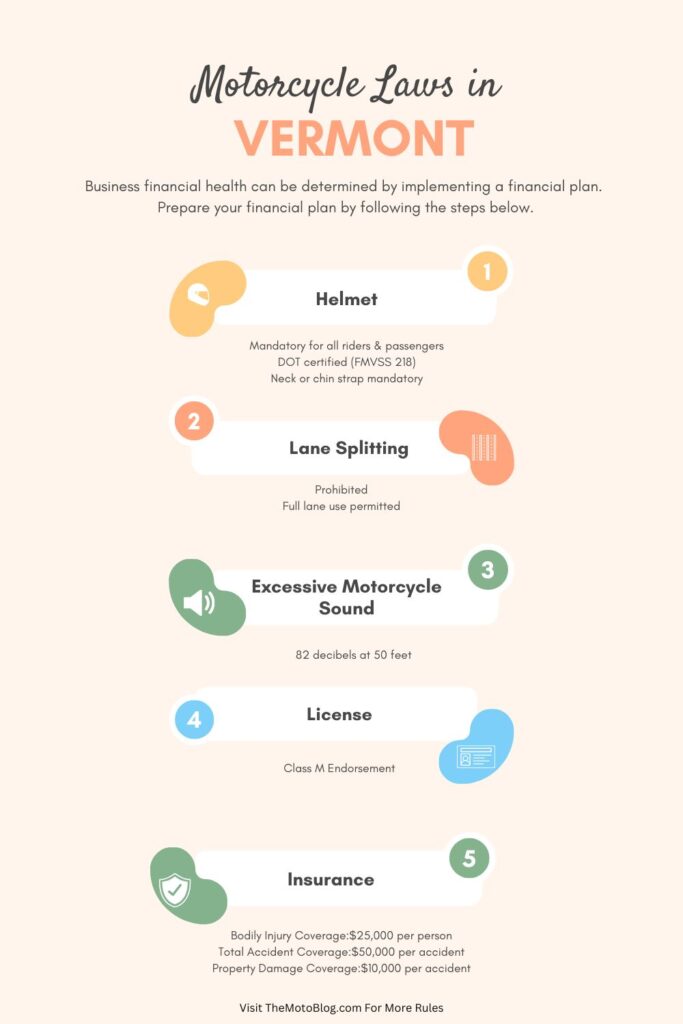Motorcycle Laws in Vermont: A Comprehensive Guide for Riders
Vermont’s winding roads through the Green Mountains and scenic valleys make it a prime destination for motorcycle enthusiasts. For riders exploring the Northeast, understanding Vermont’s motorcycle laws is crucial, especially when traveling from New Hampshire or Massachusetts. The state’s motorcycle regulations aim to balance rider freedom with safety requirements, protecting both motorcyclists and other road users. Whether you’re a resident or planning to cross through from New York, knowing these laws will ensure a smooth and legal riding experience in the Green Mountain State.

| Requirement | Specification |
|---|---|
| License Type | Class M Endorsement |
| Minimum Age | 16 years old |
| Written Test | 25 questions (minimum 20 correct) |
| Permit Validity | 120 days (2 possible renewals) |
| Permit Restrictions | Daylight only, no passengers, Vermont only |
| Helmet Requirement | Mandatory for all riders & passengers |
| Helmet Standard | DOT certified (FMVSS 218) |
| Eye Protection | Required unless windshield present |
| Helmet Strap | Neck or chin strap mandatory |
| Lane Splitting | Prohibited |
| Lane Usage | Full lane use permitted |
| Mirrors | Required by law |
| Passenger Footrests | Required when carrying passenger |
| Bodily Injury Coverage | $25,000 per person |
| Total Accident Coverage | $50,000 per accident |
| Property Damage Coverage | $10,000 per accident |
| Noise Limit | 82 decibels at 50 feet |
| Handlebar Height | Max 15 inches above seat |
| Passenger Seating | Permanent and regular seat required |
| Insurance Documentation | Must carry proof in vehicle |
| Vehicle Inspection | Periodic safety inspection required |
| Highway Speed Limit | 65 MPH on rural interstates |
| Violation Penalties | Up to $500 |
| Insurance Violation | Civil penalty up to $500 |
Licensing Requirements
To legally operate a motorcycle in Vermont, riders must obtain a Class M License endorsement. The process includes passing a 25-question multiple choice written test, requiring at least 20 correct answers, followed by a mandatory skills test. Applicants must provide essential documentation including:
- Birth certificate
- Driver’s license
- Social Security Number
- Proof of Vermont registration
- Liability insurance verification
Instructional Permits
Instructional permits remain valid for 120 days with two possible renewals. Permit holders must observe specific restrictions:
- Daylight operation only
- No passengers allowed
- Valid exclusively in Vermont
Helmet and Safety Equipment Laws
Vermont maintains strict safety equipment requirements. All riders and passengers must wear DOT-certified helmets meeting U.S. Department of Transportation standards (FMVSS 218). These helmets must include a neck or chin strap. Eye protection is mandatory unless the motorcycle has a windshield.
Operating Rules and Regulations
Motorcyclists are entitled to full lane usage, though lane splitting is strictly prohibited. Learner’s permit holders cannot carry passengers. Mirrors are required by law, and footrests must be installed when carrying passengers.
Insurance Requirements
Vermont mandates minimum liability coverage:
- $25,000 bodily injury per person
- $50,000 bodily injury per accident
- $10,000 property damage per accident
Vehicle Specifications
The state enforces specific vehicle requirements:
- Maximum noise limit of 82 decibels at 50 feet
- Handlebar height restricted to 15 inches above operator’s seat
Passenger Laws
Passengers must ride on a permanent and regular seat equipped with required footrests.
Registration and Documentation
Riders must:
- Carry proof of insurance
- Undergo periodic safety inspections
- Maintain current registration
Traffic Laws and Road Rules
Speed limits on designated rural interstate highways are set at 65 MPH.
Penalties and Enforcement
Violations can result in:
- Administrative penalties up to $500
- Civil penalties up to $500 for insurance violations
Special Circumstances
Law enforcement officers receive exemptions from certain lane usage restrictions while performing official duties.
Understanding and following Vermont’s motorcycle laws is essential for both safety and legal compliance. These regulations align with many neighboring states but have their own unique requirements that riders should carefully note. For those planning cross-state adventures, it’s worth comparing these laws with those of Maine and Connecticut, as requirements can vary at state borders. Vermont’s comprehensive motorcycle laws reflect its commitment to motorcycle safety while preserving the freedom to enjoy its scenic routes. Whether you’re riding the historic byways near Rhode Island or exploring Vermont’s own celebrated roads, staying informed about these regulations ensures a safe and enjoyable riding experience while avoiding potential penalties.
Motorcycle Laws in the US By States
If you liked this article, then please subscribe to our YouTube Channel for more Bike Videos. You can also find us on Instagram, Twitter and Facebook.
Disclosure: As an Amazon Associate, I earn from qualifying purchases. Read more about Amazon Affiliate Disclaimer.

Vishwanath Mathpati
I am Vishwanath Mathpati, a full-time Blogger and Motorcyclist from Bidar, Karnataka. I love writing about my Motorcycles Stories and Riding Gears on this blog.
Know More About Me.






